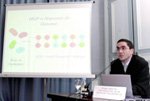 |
World's Scientists Reveal the Secrets of Human Life

World's Scientists Reveal the Secrets of Human Life
Scientists have for the first time revealed the human genome sequence with the discovery that the human genetic blueprint is only about twice the size of a fruit fly's.
The head of China's gene research team said Monday that the Human Genome Project (HGP) will publicize its version of the human genome in Nature, a well-known magazine based in London, on Thursday.
The HGP team is a consortium of academic centres, mostly from the United States and Britain but with members in France, Germany, China and Japan.
China has finished 1 per cent of the finished sequenced map, according to Liu Qian, director and professor at the China National Centre for Biotechnology Development.
He said the findings were the first complete look at a genetic document of extraordinary strangeness and complexity.
Scientists have found there are far fewer human genes than believed, probably a mere 30,000 or so -- only a third more than those in the roundworm. They have found vast expanses of desert-like regions, where the human genome sequence contains relatively few or no protein-coding genes at all.
Roughly a quarter of the genome could be considered desert, with lengthy gene-free segments.
The findings also show that more than a third of the genome contains repetitive sequences, suggesting that this so-called "junk DNA" needs further study.
In addition, every human being on the planet shares 99.99 per cent of the same genetic code with everyone else. Individual variations represent just 0.01 per cent, or 1,250 different letters, of the entire sequence.
These genetic instructions are all contained within 46 large DNA-containing molecules called chromosomes - 23 from each parent.
Liu quoted genome scientists as saying that the completed human genome sequence is expected to spur on medical advances in diagnoses, pharmaceuticals that reflect individual genetic variations, and possibly gene therapies targeting segments of the code responsible for disease.
"The new findings are historic and unprecedented and the discovery is fundamental and basic," he said.
Liu said the public should remain calm because there were still gaps in the findings and the breakthroughs could as yet only bring certain benefits.
He said ongoing research would go much further.
"The next step is to research the functions of repetitive DNA, the regulation of gene expression, protein interactions, signalling, the effects of the environment and other mechanisms that could contribute to an organism's complexity.
Liu also said that China was willing to work with scientists from all over the world to make discoveries.
"Team work has resulted in these findings and we need to continue the co-operation not only between national scientists, but also with those worldwide," Liu said.
Last May, scientists from six countries, including China, declared they had completed a draft of the human genome sequence.
With State input of about 50 million yuan (US$6 million), Chinese scientists joined about 1,000 scientists from 16 institutions around the world in the final sprint to map out the genetic code.
China has more than 30 national biotechnology research laboratories, more than 20 of which are involved in gene research in some way.
Source: China Daily

In This Section

|